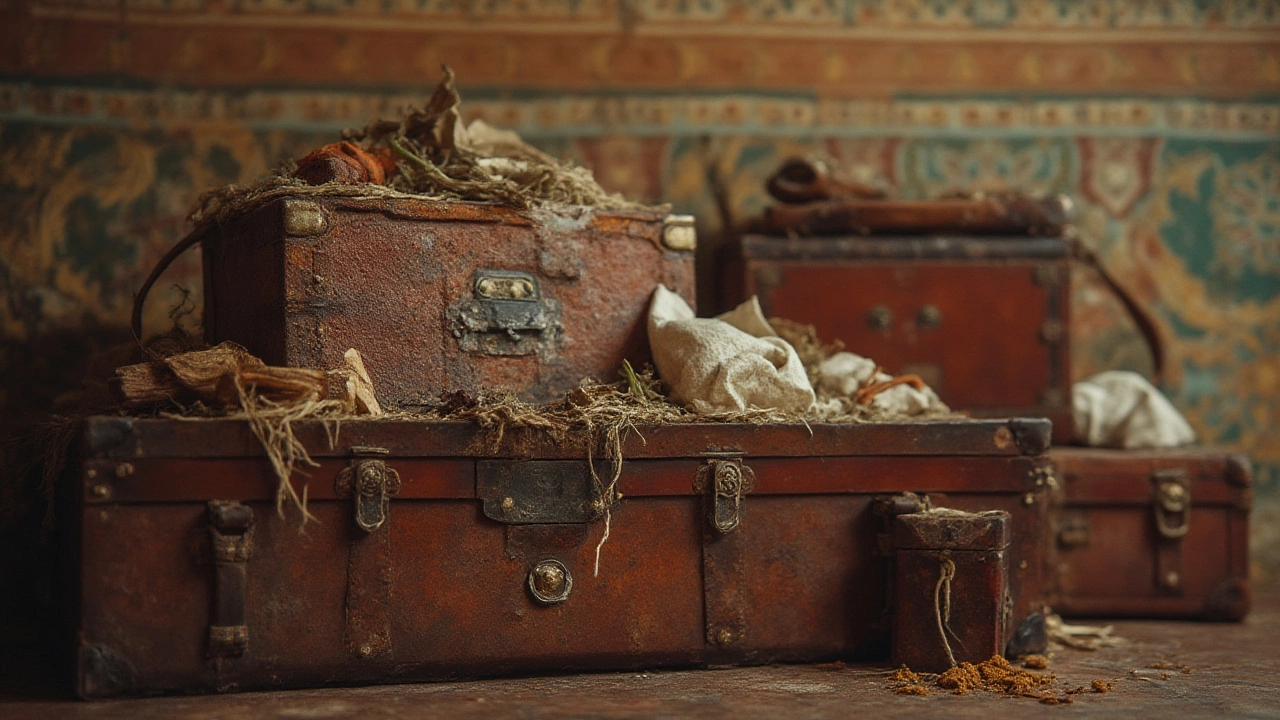Ever find yourself opening a storage box only to get hit with that unmistakable stale, earthy smell—and spot fuzzy green or black patches on your stuff? Yep, that's mold, and it’s way more common in storage areas than you’d think, especially in humid places like Melbourne. Nobody wants moldy keepsakes, rusty tools, or musty-smelling clothes. But why does mold seem to love storage so much?
The sneaky thing about mold is it silently creeps in where you least expect it. Did you know a single square inch of wall can hold thousands of dormant mold spores? All they need is a little moisture and oxygen, and boom—your boxes, furniture, or books turn into a mold hotel. Storage areas are prime targets because they're usually shut tight, dark, and often ignored for months. Mold doesn’t just ruin your stuff; it can actually wreck your health, spark allergies, or even mess up your house’s structure if it settles into the walls or floors.
Now, here’s a wild stat: the CSIRO estimates about 1 in 3 Aussie homes have some visible mold problems during the wet season. And Melbourne, known for its wild weather swings, isn’t doing us any favours. That means storage solutions need to go beyond just shoving things under the bed or into the garage. If you want your precious items to stay safe and dry, you’ve got to play defense against mold. So how do you tackle mold and keep your storage spaces fresh? Let's dig into how mold takes hold, and the best tricks to keep it well and truly out.
What Fuels Mold in Storage—and How It Spreads
Mold’s not picky. It’ll happily grow on wood, fabric, cardboard, leather, even plastic—pretty much anything except pure metal or glass. All it wants is a mix of moisture, a bit of warmth, still air, and something organic to munch on. Problems start the moment you put away something a tad damp or store in a room that’s not well-ventilated.
When you look at the science, mold spores are always floating around—indoors and out. They’re tiny (a thousand would fit on the tip of a needle), so keeping them out entirely is impossible. But those spores need particular conditions to start growing:
- Moisture: Above 60% humidity gives mold a green light. Melbourne’s winters bring plenty of rain and indoor condensation, so garages and under-housed areas can get damp without you noticing.
- Temperature:
- Most molds thrive between 15°C and 30°C—a typical storage spot year-round, even in a chilly Melbourne winter.
- Food:
- Paper, cardboard, wool, cotton, and leather are all delicious to mold. So are dust and organic grime stuck on your old things.
- Lack of light:
- Low or no sunlight lets mold multiply faster, especially in boxes, closets, and garages.
- Stale air:
- No airflow keeps dampness trapped, making things worse.
When you store items that are even slightly damp—and don’t come back for months or years—mold can break out and spread without you knowing. Sometimes all it takes is a rainstorm seeping into your shed or a washing machine leak nearby. And when it comes to speed, mold is a record breaker. Under perfect conditions, it can sprout in as little as 24–48 hours.
Here's a quick look at which factors help (or hurt) mold in your storage:
| Factor | Favors Mold | Keeps Mold Away |
|---|---|---|
| Humidity | >60% | <50% |
| Temperature | 15°C–30°C | <10°C or >35°C |
| Light | Darkness | Direct Sunlight |
| Airflow | Stale, still | Circulating |
| Cleanliness | Dust/Organic | Clean objects |
You can see it’s usually a mix of things—humidity, temperature, and something tasty for the mold to eat. If you let any of those run wild, you’re pretty much inviting mold in for a party. So, if you want to win this battle, you have to make your storage ruthlessly unfriendly to mold.

Clever Tricks and Storage Hacks to Prevent Mold
If you want to squash mold problems for good, you’ll want to tackle its favourite conditions right at the source. A few smart habits and low-cost hacks can make a massive difference. First things first, get ruthless about what goes into storage. If it’s damp—even slightly—air it out or dry it properly before packing. Don’t just chuck your winter coat in the closet after its last rainy outing. Hang stuff out in the sun or run a fan over it until totally dry; sunlight kills mold, and airflow whisks away sneaky moisture.
- Control humidity. Grab a digital humidity meter (a hygrometer) and check your storage space. If you’re clocking over 60% humidity, mold’s licking its lips. Crack a window or use a dehumidifier, especially right after rainy spells. Remember: garages and sheds can turn muggy quicker than you think.
- Choose your storage containers wisely. Cardboard boxes are mold’s best friend—they love to absorb damp and stay musty. Switch to plastic storage bins with tight lids. For extra credit, go for clear bins so you can spot trouble without opening every box. And never jam stuff to the brim; squished items can trap dampness inside.
- Seal up leaks and watch for puddles. Got a leaky roof in your storage shed? That’s instant drama. Patch up cracks and check for dripping pipes or rising damp spots under your house. Place boxes on shelves or pallets to keep them off the cold ground, so even surprise puddles can’t sneak in.
- Improve airflow. Remember how mold hates moving air? Leave gaps between boxes, crack open the door every so often, and point a fan into the space in sticky weather. For long-term defense, you could even add a small vent or louvre window.
- Use desiccants and absorbents. Old-school silica gel packets or tubs of moisture absorber (like DampRid) can work wonders, especially in small closets or unheated rooms. Replace or recharge them every few months—they don’t last forever.
- Keep things clean. Wipe stuff before storing—dust, dirt, and organic grime act as fuel for future mold. Vacuum out cupboards, wash down bins, and wipe wooden furniture with a mix of vinegar and water to kill off existing spores.
- Add natural mold-fighters. Some folks swear by pop-in sachets of activated charcoal, chalk, or even a bowl of baking soda in tight spots. They soak up damp and zap odor at the same time.
- If you can, avoid storing anything that’s soaked with human or pet smells, as these attract more than just mold (hello, silverfish and moths). Wash clothes and linens before packing, and seal them in airtight bags for bonus protection.
- Rethink the garage and shed. These spaces are often the #1 spots for mold breakouts due to wild temperature changes and leaks. Keep sensitive stuff—like photos, books, or clothes—indoors or up high on shelves, not on the cold concrete floor or pushed into corners.
The best hack of all? Make it a habit to check your storage every few weeks, especially when the seasons change. Pop in during a rainy week and see if anything feels damp or smells off. Early action can save you a whole lot of trouble later.
Sometimes you can even score bonus points by prepping the space before you store anything: paint concrete floors with a waterproofing sealant, or run a portable heater and fan combo for an hour on stormy days to keep things dry. It’s the kind of little effort that can pay off year after year.

How to Rescue Storage Suffering from Mold
Let’s say you didn’t get to this article in time and you’ve already found some mold. Take a breath—you can rescue most things if you catch the problem early. But don’t mess around: mold spreads fast, and it can wreck fabrics, leathers, or wooden furniture for good if left unchecked.
- First, evacuate. Remove anything with visible mold and bag it up before you spread spores around the rest of the house. Take moldy stuff outside—even a sunny balcony will do—to stop the spread indoors.
- Clean hard surfaces with a one-to-one mix of white vinegar and water. Spray it on, scrub with a brush (wear gloves), and wipe dry. Vinegar can actually kill most surface molds, especially the types that favor Aussie homes.
- Wash fabrics and soft toys in hot water with a splash of vinegar or baking soda added to your normal wash. For stubborn patches, pre-soak before you toss them in the machine. Don’t store until bone dry.
- For books, photos, or other delicate stuff, lightly brush off the dried mold outdoors. Place in sunlight for a few hours—it’s a natural mold killer. Don’t use harsh chemicals or douse paper items in liquid.
- If you spot black spots on painted walls or ceilings, wear a mask. Use a mix of one-part bleach to three-parts water, scrub gently, rinse, and dry thoroughly. Sometimes mold has gotten into the walls—if stains keep coming back, it might be time to call in pros for advice.
- Air the whole space for at least a day. Open all the boxes, run a fan, and bring in some sunlight if possible. Repeat the cleaning for persistent patches, and if you have carpet or rugs, shampoo or steam clean them before putting back.
- Once everything’s clean, only store dry, mold-free things, and add a fresh lot of silica gel packs or baking soda containers before closing up the bins again.
If the outbreak looks really bad or the air smells foul even after cleaning, think twice before trying to salvage. Moldy wooden furniture and mattresses often hide deep-set spores; it may be safer to let them go. You don’t want to gamble with your health just to save a lounge chair that was never your favorite anyway.
And if your storage area itself is a repeat offender—always damp, with peeling paint or constant leaks—think about long-term fixes. Get leaks patched, use mold-resistant paint, and sort out airflow. Sometimes investing a bit now saves you a heap of money and heartache later. For typical Melbourne homes, a quality dehumidifier can make all the difference, especially through the soggy months from May to September.
Mold might be relentless, but armed with these tips and a bit of regular attention, you can finally keep those fuzzy invaders out of your storage—and give your gear, clothes, and keepsakes the fresh, safe home they deserve.

